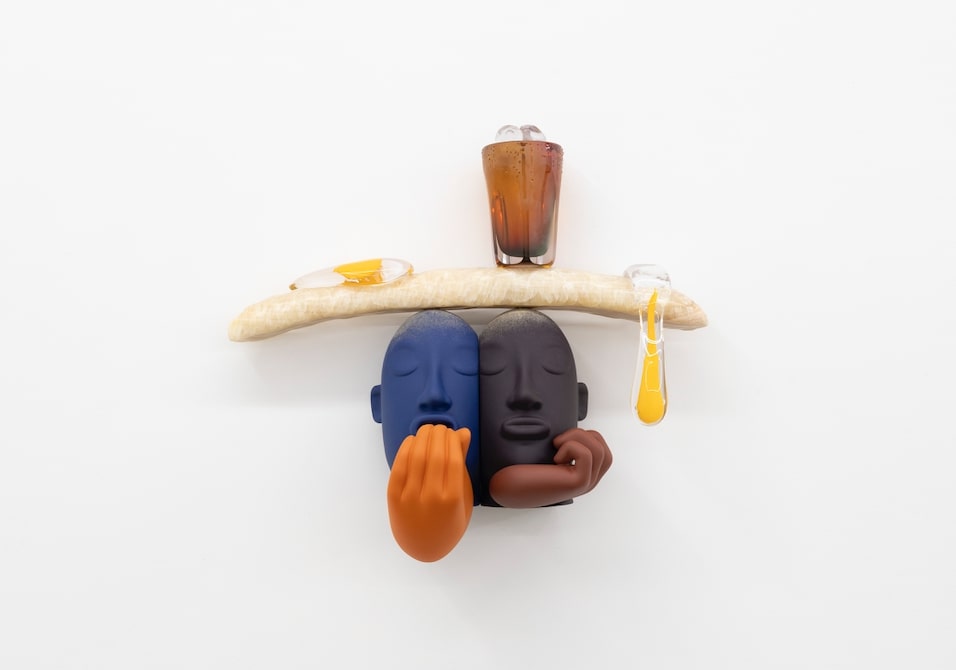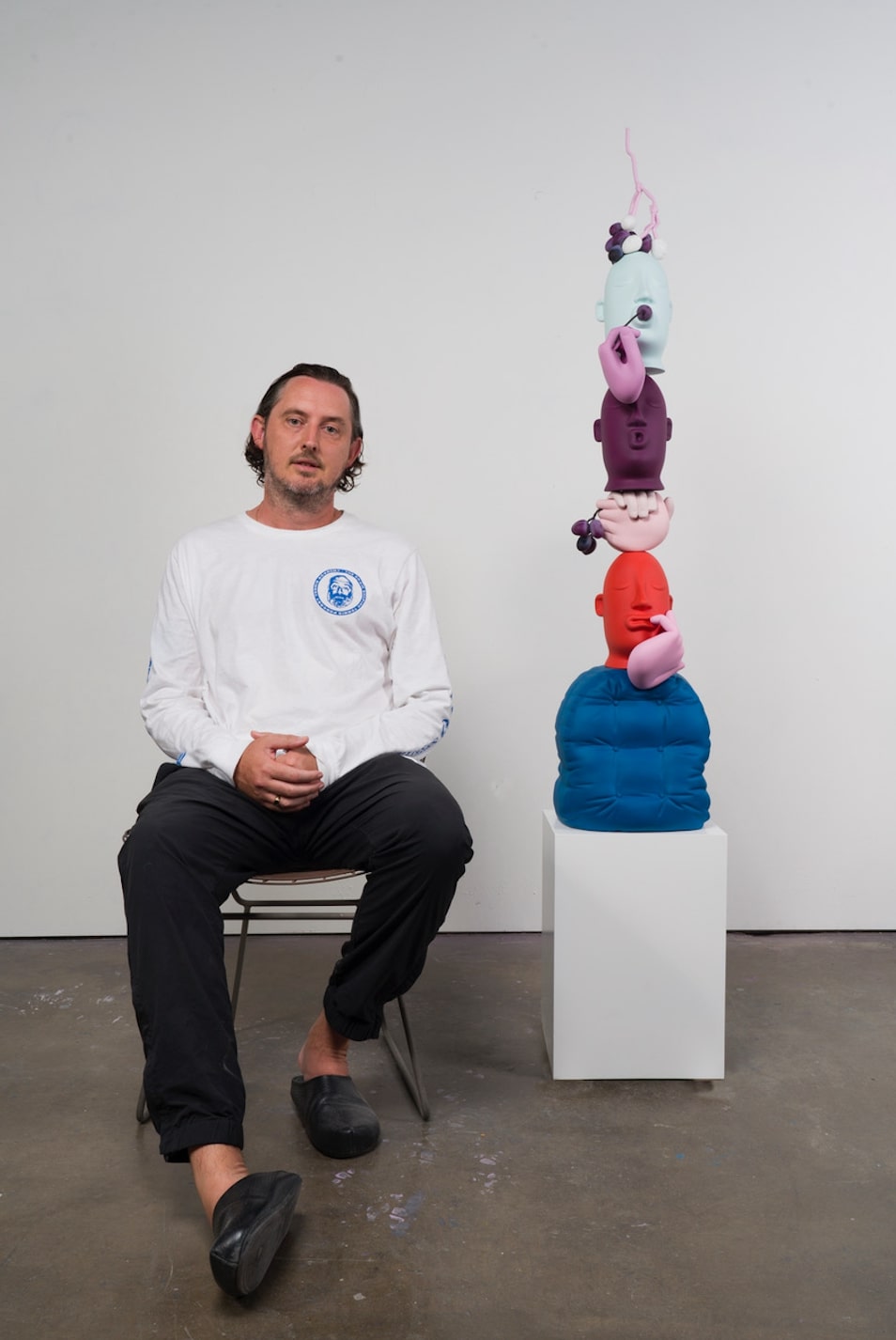Mark Whalen‘s sculptures are not your typical sculptures. They are both fun and meaningful, inviting viewers to reconsider the mundane moments that make up life. A melting clock draped over a chair, a baguette rendered in marble, a figure precariously balancing a stack of broken eggshells – these are just a few of the images that populate Whalen’s world, a world where the ordinary is filled with a sense of the surreal and the everyday becomes a stage for exploring the complexities of human emotion.
The Australian artist, who last year presented a captivating solo exhibition at Casa Gilardi (the final architectural masterpiece by renowned Mexican architect Luis Barragán), has been steadily gaining international recognition. His work has been featured in group exhibitions around the world from Los Angeles, Tokyo to Hong Kong, and he recently had a solo show at Station Gallery in Sydney as well as having a new sculpture at Richard Heller Gallery current group show in Los Angeles.
I sat down in his light-filled Los Angeles home, warmly greeted by him and his bulldog terrier, Leon. A stack of art books lay on the coffee table, some from his fellow artists friends and others from artists he looks up to. Whalen’s artistic journey began in a tough Sydney suburb, where he found escape from daily life through art. He later discovered the Surrealists, and like Dalí, he is interested in disrupting our perception of reality. But while Dalí explores the realm of dreams and the unconscious, Whalen finds his inspiration in the everyday objects and actions – a bored expression, a cup of coffee, a wilting flower – and transforms them into sculptures that are both humorous and deeply resonant.

“It’s about finding the extraordinary in the ordinary,” Whalen explains, “and inviting viewers to connect with those moments in a new way.” He achieves this by isolating and recontextualizing these commonplace occurrences, forcing us to see them with fresh eyes. A clock dipped in coffee becomes a meditation on time and its relentless passage. A baguette carved from marble elevates the simple act of eating to an almost sacred ritual.
Whalen’s meticulous process begins long before he enters his studio. He immerses himself in research, poring over archival images and art books. He finds inspiration in the compositions and muted tones of Giorgio Morandi’s still life paintings, where humble bottles and jars become instilled with a quiet poetry. He’s also drawn to the work of Alberto Giacometti, whose elongated figures seem to embody the existential anxieties of modern life. But Whalen’s greatest source of inspiration is the world around him.
“I’m fascinated by those universal experiences that connect us all,” he says. “Whether it’s the frustration of running late, the weight of an emotional overload, or the simple pleasure of a shared laugh, I seek out those quirky, relatable moments that reveal something essential about how we think and communicate.”

Whalen’s early sculptures were primarily constructed from polyurethane on aluminum, but over the years he has embraced a wider range of materials, including marble, glass, and onyx. “I’m really fascinated by the interplay between different materials,” he shares. This experimentation introduces new challenges, as each material requires unique treatment and handling. “It’s a challenge to bring these disparate elements together in a way that feels harmonious and meaningful, but that’s exactly what excites me!”
The mix of materials in his work often creates a trompe l’oeil effect, like in his new sculpture currently on view at Richard Heller where the marble appears as frozen ice and the glass resembles melted droplets on the grapes. “I’m interested in how these materials can enhance the narrative I’m trying to convey,” Whalen explains, “adding layers of complexity and visual interest to the conversation.”


Color is as crucial to Whalen’s sculptures as the materials themselves. He cites Ugo Rondinone, renowned for his vibrant, large-scale public art installations like Seven Magic Mountains, as an influence, particularly Rondinone’s bold use of color to transform landscapes. Like a painter selecting hues from a palette, Whalen carefully considers the interplay of light and shadow, opacity and translucency. In his sculpture “Slow Burn”, for example, the deep blue of the painted aluminum contrasts with the light painted bronze used for the melting candles, creating a sense of melancholy and the passage of time. “I’m exploring how these diverse textures and colors can coexist and create a dialogue within a single piece,” he explains.
But perhaps the most interesting aspect of Whalen’s work is its ability to make us reflect on our own internal struggles and anxieties while simultaneously bringing a twist of humor. “Cracked Egg,” for instance, features a figure precariously balancing a stack of broken eggshells. “We’re all constantly juggling fragile situations,” he explains, “This sculpture is a reminder that even when things feel broken or precarious, there’s still a sense of beauty and resilience to be found.”

Whalen has been open about his own struggles with mental health, and his personal experiences inform his artistic practice which resonates with viewers on a deeply personal level. “We’re all constantly navigating the delicate balance between order and chaos,” he reflects. He invites us to look closer, to find the extraordinary in the ordinary. “These sculptures are my way of acknowledging that reality, but also finding a bit of humor and lightness in it.”

